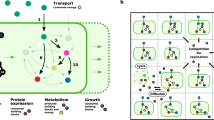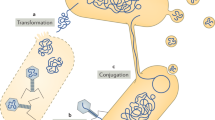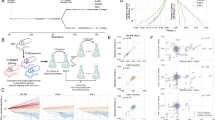Abstract
Numerous studies have considered the emergence of metabolic pathways1, but the modes of recent evolution of metabolic networks are poorly understood. Here, we integrate comparative genomics with flux balance analysis to examine (i) the contribution of different genetic mechanisms to network growth in bacteria, (ii) the selective forces driving network evolution and (iii) the integration of new nodes into the network. Most changes to the metabolic network of Escherichia coli in the past 100 million years are due to horizontal gene transfer, with little contribution from gene duplicates. Networks grow by acquiring genes involved in the transport and catalysis of external nutrients, driven by adaptations to changing environments. Accordingly, horizontally transferred genes are integrated at the periphery of the network, whereas central parts remain evolutionarily stable. Genes encoding physiologically coupled reactions are often transferred together, frequently in operons. Thus, bacterial metabolic networks evolve by direct uptake of peripheral reactions in response to changed environments.
This is a preview of subscription content, access via your institution
Access options
Subscribe to this journal
Receive 12 print issues and online access
$209.00 per year
only $17.42 per issue
Buy this article
- Purchase on SpringerLink
- Instant access to full article PDF
Prices may be subject to local taxes which are calculated during checkout



Similar content being viewed by others
References
Schmidt, S., Sunyaev, S., Bork, P. & Dandekar, T. Metabolites: a helping hand for pathway evolution? Trends Biochem. Sci. 28, 336–341 (2003).
Lawrence, J.G. & Hendrickson, H. Lateral gene transfer: when will adolescence end? Mol. Microbiol. 50, 739–749 (2003).
Lerat, E., Daubin, V., Ochman, H. & Moran, N.A. Evolutionary origins of genomic repertoires in bacteria. PLoS Biol. 3, e130 (2005).
Teichmann, S.A. et al. The evolution and structural anatomy of the small molecule metabolic pathways in Escherichia coli. J. Mol. Biol. 311, 693–708 (2001).
Rison, S.C., Teichmann, S.A. & Thornton, J.M. Homology, pathway distance and chromosomal localization of the small molecule metabolism enzymes in Escherichia coli. J. Mol. Biol. 318, 911–932 (2002).
Alves, R., Chaleil, R.A. & Sternberg, M.J. Evolution of enzymes in metabolism: a network perspective. J. Mol. Biol. 320, 751–770 (2002).
Reed, J.L., Vo, T.D., Schilling, C.H. & Palsson, B.O. An expanded genome-scale model of Escherichia coli K-12 (iJR904 GSM/GPR). Genome Biol. 4, R54 (2003).
Lawrence, J.G., Hartl, D.L. & Ochman, H. Molecular considerations in the evolution of bacterial genes. J. Mol. Evol. 33, 241–250 (1991).
Ochman, H. & Groisman, E.A. The origin and evolution of species differences in Escherichia coli and Salmonella typhimurium. EXS 69, 479–493 (1994).
Snel, B., Bork, P. & Huynen, M.A. Genomes in flux: the evolution of archaeal and proteobacterial gene content. Genome Res. 12, 17–25 (2002).
Mirkin, B.G., Fenner, T.I., Galperin, M.Y. & Koonin, E.V. Algorithms for computing parsimonious evolutionary scenarios for genome evolution, the last universal common ancestor and dominance of horizontal gene transfer in the evolution of prokaryotes. BMC Evol. Biol. 3, 2 (2003).
Boussau, B., Karlberg, E.O., Frank, A.C., Legault, B.A. & Andersson, S.G. Computational inference of scenarios for alpha-proteobacterial genome evolution. Proc. Natl. Acad. Sci. USA 101, 9722–9727 (2004).
Lawrence, J.G. & Ochman, H. Molecular archaeology of the Escherichia coli genome. Proc. Natl. Acad. Sci. USA 95, 9413–9417 (1998).
Keseler, I.M. et al. EcoCyc: a comprehensive database resource for Escherichia coli. Nucleic Acids Res. 33, D334–D337 (2005).
Papp, B., Pál, C. & Hurst, L.D. Metabolic network analysis of the causes and evolution of enzyme dispensability in yeast. Nature 429, 661–664 (2004).
Hooper, S.D. & Berg, O.G. On the nature of gene innovation: duplication patterns in microbial genomes. Mol. Biol. Evol. 20, 945–954 (2003).
Gerdes, S.Y. et al. Experimental determination and system level analysis of essential genes in Escherichia coli MG1655. J. Bacteriol. 185, 5673–5684 (2003).
Thatcher, J.W., Shaw, J.M. & Dickinson, W.J. Marginal fitness contributions of nonessential genes in yeast. Proc. Natl. Acad. Sci. USA 95, 253–257 (1998).
Price, N.D., Reed, J.L. & Palsson, B.O. Genome-scale models of microbial cells: evaluating the consequences of constraints. Nat. Rev. Microbiol. 2, 886–897 (2004).
Segre, D., Vitkup, D. & Church, G.M. Analysis of optimality in natural and perturbed metabolic networks. Proc. Natl. Acad. Sci. USA 99, 15112–15117 (2002).
Reed, J.L. & Palsson, B.O. Genome-scale in silico models of E. coli have multiple equivalent phenotypic states: assessment of correlated reaction subsets that comprise network states. Genome Res. 14, 1797–1805 (2004).
Taoka, M. et al. Only a small subset of the horizontally transferred chromosomal genes in Escherichia coli are translated into proteins. Mol. Cell. Proteomics 3, 780–787 (2004).
Burgard, A.P., Nikolaev, E.V., Schilling, C.H. & Maranas, C.D. Flux coupling analysis of genome-scale metabolic network reconstructions. Genome Res. 14, 301–312 (2004).
Snel, B. & Huynen, M.A. Quantifying modularity in the evolution of biomolecular systems. Genome Res. 14, 391–397 (2004).
Salgado, H. et al. RegulonDB (version 4.0): transcriptional regulation, operon organization and growth conditions in Escherichia coli K-12. Nucleic Acids Res. 32, D303–D306 (2004).
Jain, R., Rivera, M.C. & Lake, J.A. Horizontal gene transfer among genomes: the complexity hypothesis. Proc. Natl. Acad. Sci. USA 96, 3801–3806 (1999).
Almaas, E., Kovacs, B., Vicsek, T., Oltvai, Z.N. & Barabasi, A.L. Global organization of metabolic fluxes in the bacterium Escherichia coli. Nature 427, 839–843 (2004).
von Mering, C. et al. STRING: known and predicted protein-protein associations, integrated and transferred across organisms. Nucleic Acids Res. 33, D433–D437 (2005).
Forster, J., Famili, I., Fu, P., Palsson, B.O. & Nielsen, J. Genome-scale reconstruction of the Saccharomyces cerevisiae metabolic network. Genome Res. 13, 244–253 (2003).
Kellis, M., Birren, B.W. & Lander, E.S. Proof and evolutionary analysis of ancient genome duplication in the yeast Saccharomyces cerevisiae. Nature 428, 617–624 (2004).
Acknowledgements
We thank P. Bork, L. Hurst and S. McWeeney for suggestions on previous versions of the manuscript; C. von Mering for discussions and providing early access to the updated STRING database; and E. Nikolaev for discussions on flux coupling analysis. C.P. and B.P. are supported by the Hungarian Scientific Research Fund. B.P. is a Fellow of the Human Frontier Science Program. C.P. acknowledges support by an EMBO Long-Term Fellowship. M.J.L. acknowledges support by the Deutsche Forschungsgemeinschaft.
Author information
Authors and Affiliations
Corresponding author
Ethics declarations
Competing interests
The authors declare no competing financial interests.
Supplementary information
Supplementary Fig. 1
Phylogenetic tree of 56 proteobacterial species. (PDF 19 kb)
Supplementary Fig. 2
Virus- and transposon-related functions of transferred genes. (PDF 77 kb)
Supplementary Fig. 3
Dependence of GC and codon usage bias on transfer age. (PDF 71 kb)
Supplementary Table 1
Transfer numbers on each phylogenetic branch. (PDF 24 kb)
Supplementary Table 2
Supplementary results. (PDF 29 kb)
Supplementary Table 3
Growth conditions and biomass composition for FBA. (PDF 24 kb)
Rights and permissions
About this article
Cite this article
Pál, C., Papp, B. & Lercher, M. Adaptive evolution of bacterial metabolic networks by horizontal gene transfer. Nat Genet 37, 1372–1375 (2005). https://doi.org/10.1038/ng1686
Received:
Accepted:
Published:
Issue Date:
DOI: https://doi.org/10.1038/ng1686
This article is cited by
-
Trade-off in genome turnover events leading to adaptive evolution of Microcystis aeruginosa species complex
BMC Genomics (2023)
-
Silent gene clusters encode magnetic organelle biosynthesis in a non-magnetotactic phototrophic bacterium
The ISME Journal (2023)
-
Modular evolution of secretion systems and virulence plasmids in a bacterial species complex
BMC Biology (2022)
-
Comparative genomics reveals broad genetic diversity, extensive recombination and nascent ecological adaptation in Micrococcus luteus
BMC Genomics (2021)
-
Assessment of assumptions underlying models of prokaryotic pangenome evolution
BMC Biology (2021)



